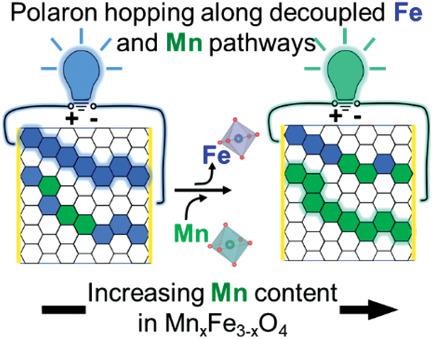当前位置:
X-MOL 学术
›
Adv. Mater.
›
论文详情
Our official English website, www.x-mol.net, welcomes your
feedback! (Note: you will need to create a separate account there.)
Breakdown of the Small‐Polaron Hopping Model in Higher‐Order Spinels
Advanced Materials ( IF 27.4 ) Pub Date : 2020-10-21 , DOI: 10.1002/adma.202004490 Anuj Bhargava 1 , Roni Eppstein 2 , Jiaxin Sun 1 , Michelle A. Smeaton 1 , Hanjong Paik 1, 3 , Lena F. Kourkoutis 4, 5 , Darrell G. Schlom 1, 5, 6 , Maytal Caspary Toroker 2, 7 , Richard D. Robinson 1
Advanced Materials ( IF 27.4 ) Pub Date : 2020-10-21 , DOI: 10.1002/adma.202004490 Anuj Bhargava 1 , Roni Eppstein 2 , Jiaxin Sun 1 , Michelle A. Smeaton 1 , Hanjong Paik 1, 3 , Lena F. Kourkoutis 4, 5 , Darrell G. Schlom 1, 5, 6 , Maytal Caspary Toroker 2, 7 , Richard D. Robinson 1
Affiliation

|
The small‐polaron hopping model has been used for six decades to rationalize electronic charge transport in oxides. The model was developed for binary oxides, and, despite its significance, its accuracy has not been rigorously tested for higher‐order oxides. Here, the small‐polaron transport model is tested by using a spinel system with mixed cation oxidation states (MnxFe3−xO4). Using molecular‐beam epitaxy (MBE), a series of single crystal MnxFe3−xO4 thin films with controlled stoichiometry, 0 ≤ x ≤ 2.3, and lattice strain are grown, and the cation site‐occupation is determined through X‐ray emission spectroscopy (XES). Density functional theory + U analysis shows that charge transport occurs only between like‐cations (Fe/Fe or Mn/Mn). The site‐occupation data and percolation models show that there are limited stoichiometric ranges for transport along Fe and Mn pathways. Furthermore, due to asymmetric hopping barriers and formation energies, the polaron is energetically preferred to the polaron, resulting in an asymmetric contribution of Mn/Mn pathways. All of these findings are not contained in the conventional small‐polaron hopping model, highlighting its inadequacy. To correct the model, new parameters in the nearest‐neighbor hopping equation are introduced to account for percolation, cross‐hopping, and polaron‐distribution, and it is found that a near‐perfect correlation can be made between experiment and theory for the electronic conductivity.
中文翻译:

高阶尖晶石中小极化子跳跃模型的分解
小极化子跳跃模型已经使用了六十年,以合理化氧化物中的电子电荷传输。该模型是针对二元氧化物开发的,尽管意义重大,但尚未针对高阶氧化物严格测试其准确性。在这里,小极化子传输模型是通过使用具有混合阳离子氧化态(Mn x Fe 3− x O 4)的尖晶石系统测试的。使用分子束外延(MBE),一系列单晶的Mn X铁3- X Ò 4薄膜具有受控化学计量,0≤ X ≤2.3,并增长晶格应变,并通过X射线发射光谱(XES)确定阳离子的位点占据。密度泛函理论+ U分析表明,电荷传输仅发生在相似的阳离子(Fe / Fe或Mn / Mn)之间。场所占用数据和渗流模型表明,沿着Fe和Mn途径传输的化学计量范围有限。此外,由于不对称的跳跃势垒和形成能, 极化子在能量上比 极化子,导致Mn / Mn途径的不对称贡献。所有这些发现都没有包含在常规的小极化子跳跃模型中,这突出了它的不足。为了校正模型,引入了最近邻跳变方程中的新参数来说明渗流,交叉跳变和极化子分布,并且发现可以在电子的实验和理论之间建立接近完美的关联。电导率。
更新日期:2020-12-08
中文翻译:

高阶尖晶石中小极化子跳跃模型的分解
小极化子跳跃模型已经使用了六十年,以合理化氧化物中的电子电荷传输。该模型是针对二元氧化物开发的,尽管意义重大,但尚未针对高阶氧化物严格测试其准确性。在这里,小极化子传输模型是通过使用具有混合阳离子氧化态(Mn x Fe 3− x O 4)的尖晶石系统测试的。使用分子束外延(MBE),一系列单晶的Mn X铁3- X Ò 4薄膜具有受控化学计量,0≤ X ≤2.3,并增长晶格应变,并通过X射线发射光谱(XES)确定阳离子的位点占据。密度泛函理论+ U分析表明,电荷传输仅发生在相似的阳离子(Fe / Fe或Mn / Mn)之间。场所占用数据和渗流模型表明,沿着Fe和Mn途径传输的化学计量范围有限。此外,由于不对称的跳跃势垒和形成能, 极化子在能量上比 极化子,导致Mn / Mn途径的不对称贡献。所有这些发现都没有包含在常规的小极化子跳跃模型中,这突出了它的不足。为了校正模型,引入了最近邻跳变方程中的新参数来说明渗流,交叉跳变和极化子分布,并且发现可以在电子的实验和理论之间建立接近完美的关联。电导率。











































 京公网安备 11010802027423号
京公网安备 11010802027423号